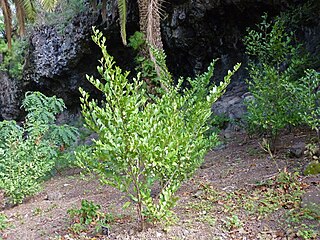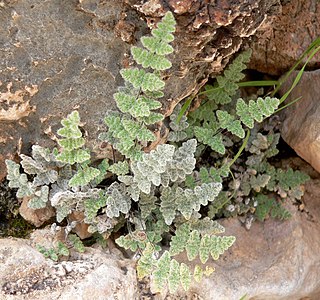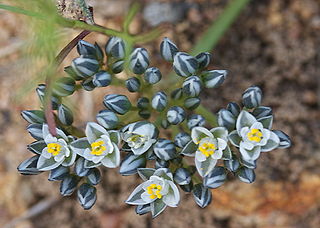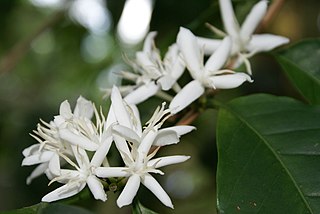
Monotaxis is a plant genus in the family Euphorbiaceae first described as a genus in 1829. The entire genus is endemic to Australia.
- Monotaxis bracteataNees ex Klotzsch - Western Australia
- Monotaxis grandifloraEndl. - Western Australia
- Monotaxis linifoliaBrongn. - New South Wales
- Monotaxis luteifloraF.Muell. - Western Australia, South Australia, Northern Territory
- Monotaxis macrophyllaBenth. - Queensland, New South Wales
- Monotaxis occidentalisEndl. - Western Australia
- Monotaxis paxiiGrüning - Western Australia
- Monotaxis tenuisAiry Shaw - N Western Australia, N Northern Territory

Selenicereus, sometimes known as moonlight cactus, is a genus of epiphytic, lithophytic, and terrestrial cacti, found in Mexico, Central America, the Caribbean and northern South America. The term night-blooming cereus is also sometimes used, but this is also used for many night-blooming cacti, including Epiphyllum and Peniocereus. In 2017, the genus Hylocereus was brought into synonymy with Selenicereus. A number of species of Selenicereus produce fruit that is eaten. The fruit, known as pitaya or pitahaya in Spanish or as dragon fruit, may be collected from the wild or the plants may be cultivated.

Cardiocrinum is a genus of bulbous plants of the lily family first described in 1846. They are native to the Himalaya, China, the Russian Far East, and Japan. The bulbs are usually formed at the soil surface. The preferred habitat is woodland. The plants tend to be monocarpic, dying after flowering.

Juniperus procera is a coniferous tree native to mountainous areas in Africa and the Arabian Peninsula. It is a characteristic tree of the Afromontane flora.
Georg Heinrich Wilhelm Schimper in Amharic sources known as Sambar was a renowned German botanist and naturalist, who spent more than forty years in Ethiopia collecting specimens of plants, mainly in Semien, the Tekeze area and around Adwa. Schimper discovered more new African plant species than possibly any other botanist, and numerous plant species bear the epithet Schimperi/Schimperiana.

Hopea is a genus of plants in the family Dipterocarpaceae. The genus was named after John Hope, 1725–1786, the first Regius Keeper of the Royal Botanic Garden, Edinburgh. It contains some 113 species, distributed from Sri Lanka and southern India to southern China, and southward throughout Malesia to New Guinea. They are mainly main and subcanopy trees of lowland rainforest, but some species can become also emergent trees, such as Hopea nutans.
Pseudolmedia is a flowering plant genus in the mulberry family (Moraceae). Species are found in southern Mexico, the Caribbean, and Meso- and South America. They are known in Latin America as lechechiva and used for timber, construction wood, and sometimes in folk medicine.

VisneaL.f. is a monotypic genus of plant in family Pentaphylacaceae. The genus only contains the following species ; Visnea mocaneraL.f. which is native to the Canary Islands and Madeira.

Ehretia is a genus of flowering plants in the borage family, Boraginaceae. It contains about 50 species. The generic name honors German botanical illustrator Georg Dionysius Ehret (1708–1770).

Lumnitzera is an Indo-West Pacific mangrove genus in the family Combretaceae. An English common name is black mangrove. Lumnitzera, named after the German botanist, Stephan Lumnitzer (1750-1806), occurs in mangroves from East Africa to the Western Pacific, and northern Australia.
Gumuia is a genus of extinct vascular plants of the Early Devonian. The genus was first described in 1989 based on fossil specimens from the Posongchong Formation, Wenshan district, Yunnan, China.

Cheilanthoideae is one of the five subfamilies of the fern family Pteridaceae. The subfamily is thought to be monophyletic, but some of the genera into which it has been divided are not, and the taxonomic status of many of its genera and species remains uncertain, with radically different approaches in use as of December 2019.

Limeum is a genus of flowering plants. It includes 25 species.
The World Checklist of Selected Plant Families is an "international collaborative programme that provides the latest peer reviewed and published opinions on the accepted scientific names and synonyms of selected plant families." Maintained by the Royal Botanic Gardens, Kew, it is available online, allowing searches for the names of families, genera and species, as well as the ability to create checklists.

Coffeeae is a tribe of flowering plants in the family Rubiaceae and contains about 333 species in 11 genera. Its representatives are found in tropical and southern Africa, Madagascar, the western Indian Ocean, tropical and subtropical Asia, and Queensland.

Lycopodioideae is a subfamily in the family Lycopodiaceae in the Pteridophyte Phylogeny Group classification of 2016. It is equivalent to a broad circumscription of the genus Lycopodium in other classifications. Like all lycophytes, members of the Lycopodioideae reproduce by spores. The oldest fossils of modern members of the family date to the Early Cretaceous.
Wuodendron is a genus of plants in the family Annonaceae and tribe Miliuseae, containing the type and only species Wuodendron praecox. It is distributed from northeastern India north to southern China and southeast through most of Mainland Southeast Asia.
Ochetophila is a genus of flowering plants in the family Rhamnaceae, native to Chile and Argentina. The species in this genus are actinorhizal plants.

Anne M. Schot is a Nederlander botanist.
Schimpera is a monotypic genus of flowering plants belonging to the family Brassicaceae. The only species is Schimpera arabica.












